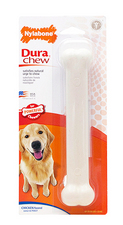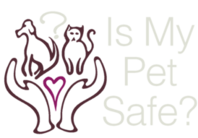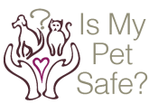Chew Toys For Dogs
Chewing. Its what young dogs do. Even some senior dogs still like a good chew. Pet parents have many choices of chew toys to purchase and a dog in the chew aisle is sure to egg on Mom or Dad to "pick that one!" But not all chew toys are created equal. Each has a range of safety concerns that should be balanced against your dog's unique traits.

Primary Concerns
All chew toys share a common set of safety issue:
- bacteria
- damaged teeth
- choking
- digestibility
- allergy
Every toy on the market falls into at least one or two of those categories.
Bacteria
Bacteria borne illness, such as salmonella or e-coli, is applicable to natural products such as bones, pig ears, antlers, hooves and similar. Most of those items seen in pet store bins are not sterilized and are susceptible to picking up additional contamination in transport and storage. This poses a risk to humans as well as pets.
Binned deer or elk antlers may also be contaminated by bacteria associated with the transmission of Chronic Wasting Disease, though I am not aware of any direct transmission to pets. Be aware that many antlers are picked up off the ground in the wild with no knowledge of the health of the shedding animal. Antlers that are from farm/ranch raised deer or elk should be safer as the animal meat will have been tested prior to slaughter.
Tooth Damage
Dental damage is definitely a concern with many of the chew toys on the market. Antlers, hooves, traditional nylon bones (e.g. Nylabone) and animal bones are quite hard - teeth may chip, break or, over many years, wear down.
Unfortunately, antlers are very hard and even limiting playtime can still result in chipped or broken teeth. I would only consider giving this type of chew toy to a large breed dog. Nylon bones come in many styles but more importantly, hardness. This allows pet parents to select a product that is interesting to their dog and not too hard on their teeth. I recommend avoiding hollow or barbell designs to minimize the chance of pieces breaking off.
More serious are the risks from marrow bones that can catch on a dog's lower jaw and longer bones that may develop sharp points and pierce the roof of your dog's mouth. These bones may also chip or splinter and if the pieces are swallowed, result in serious gastrointestinal injuries. I do not recommend natural animal bones.
Choking
All of the chew toys pose varying levels of choking risk. In the case of very hard toys like antlers and bones, the primary risk is the item is too small to start with or has been worn down to the point it could be accidentally swallowed. Whatever toy you choose, make sure it is sized appropriately for your dog. Don't give a small dog bone to a rottweiler!
Rawhide chews are the type most often associated with choking incidents. As the rawhide softens from the dog's saliva and chewing, gooey pieces may break off that can be swallowed and become stuck in your dog's throat. Some of this risk can be mitigated by using high quality rawhide roll-ups or pressed bones. With roll-ups, look for one that is a single large piece - when viewed end on the circular pattern should appear uniform. Lesser quality roll-ups are made from smaller pieces and do not appear uniform. Pressed rawhide, though often made from pieces, is significantly harder and longer lasting than the traditional roll-ups or bones. This makes it less likely to have pieces detach as your dog plays.
No matter what rawhide chew you select, never allow your dog to have the chew when you are not present. Unlike children, dogs are not likely to try to find Mom or Dad if something gets stuck. It is also advisable to stop the chew session if the rawhide gets too soft. If you find your dog is prone to pulling or chewing off pieces of the rawhide, these chews are not appropriate and should be discontinued.
Nylon bones are not a high choking risk toy provided the correct size is used and I generally advise erring on the large size. I would still not leave a puppy or young dog unattended, they just have a knack for getting in trouble. An older dog can probably be left safely with a nylon bone but pet parents need to take into account their dog's unique traits - a moderate hardness bone may be fine while you are home but potentially dangerous for a dog that suffers from anxiety or separation issues.
Note that in rare instances, nylon bones have broken and the smaller piece might present a choking hazard (why I avoid hollow or barbell type shapes). You as the pet parent should, after a few years of observation, know not only if you can trust your dog but also if the product withstands the abuse.
Edible type bones present a higher risk of choking to aggressive chewers who can break off much larger pieces than expected. Likewise, because they are edible and designed to taste good, a dog may try to swallow whole a small chew. Pet parents should closely monitor their dog if they give out these chews and I personally do not feel their benefits outweigh increased risks.
Digestion
Issues with digestion fall into three categories - diarrhea, blockages and piercing. The first may be the result of an edible chew toy that just does not agree with your dog and is only a risk to your floors and rugs. But diarrhea may also be a sign of a blockage.
However, blockages and piercings from sharp objects are much more serious, require examination by your vet and possibly emergency surgery. Symptoms vary depending on the size and location of the blockage - PetMD.com has a good write up.
Allergies
There are a number of chew products that are designed to be eaten and digested; corn starch based bones are one example. Most pets do not have reactions though some may, leading to skin rashes, itching or even irritable bowels. Just another reason to avoid edible chew toys.
Our Picks
Based on the pros and cons of the many types of popular chew toys, we can offer our preferred destructibles:
Nylon based bones, of which Nylabone ® is the most popular. The hardness can be selected based upon your own dog's characteristics, same for the size. It is also the only product I could feel reasonably comfortable leaving with a sensible adult dog not under constant observation.
The runner up is a quality pressed rawhide bone. My own personal experience over many years is that pressed rawhide has fewer (if any) safety issues compared to traditional roll-ups. I do not recommend rawhide "bones" or knots. Because it is really a processed leather product, always take care in brand selection, look for American hides that are also processed in the United States. Regardless, never leave your dog unattended with a rawhide chew.
Remember, every dog is different. Make sure to watch closely each time you introduce a new toy to be sure they can play with it safely.
Note: we do not receive any compensation from the makers of Nylabone


